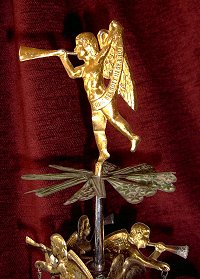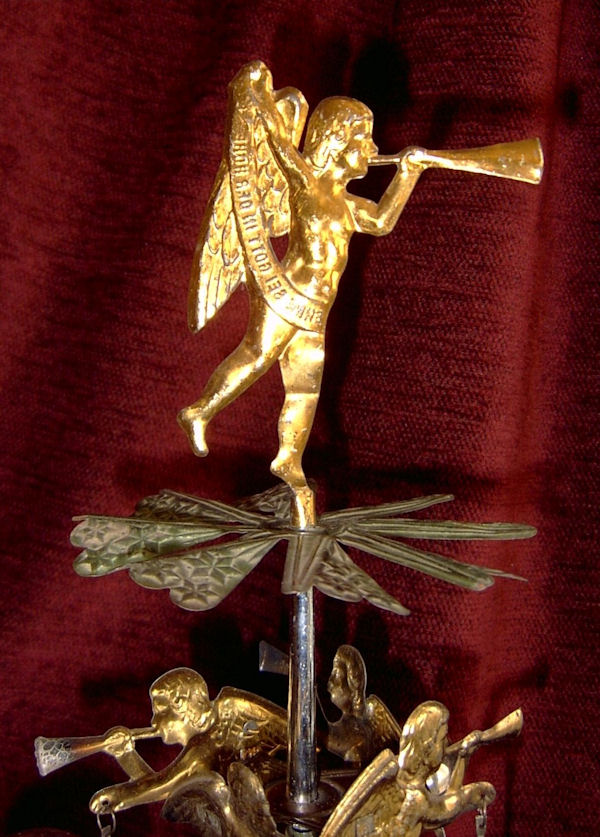|
Gallery Page
TWO
Other
Pre-World War II Angel Chimes
Adrian & Stock's "Angel Chime"
proved extremely popular, and was widely imitated. But because the
firm had the foresight to patent important design elements, it is easy to distinguish the products of other
makers from those of Adrian & Stock. If the chime
does not exhibit Adrian & Stock's exclusive design
patents (including "floating" angels carrying bell-clappers, a trumpeting angel
figure at the top of the chime, a folding tripod base, and a nativity scene as part of the design),
then the chime was not
manufactured by Adrian & Stock, although (just to
confuse things) it may have
been marketed by them — see below.
|

[Bell Brothers?] “Christbaum Engelgeläute" (Christmas
Tree Angel-Chimes)
At
left is an example of Stock’s contemporary competition
in the candle chime market, a striking and unusual chime
marketed, and perhaps manufactured, by the Solingen firm
of Gebrüder Bell. I have yet to discover any early
advertisements for it, but it most likely dates from
after 1905. The firm of Adrian & Stock held a patent on
the "floating angels" design, so while angels are also
prominent feature of this chime, here they only serve as
stationary holders for the impellers. The original box
is illustrated below.
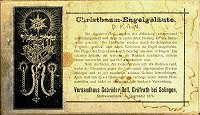
|
|
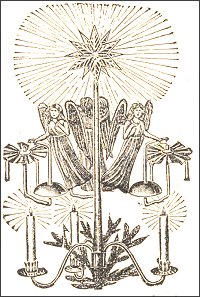
Rauh
Bros. “Engel-Geläute Stern von Bethlehem” (Angel-Chimes with the
Star of Bethlehem) (43 x 24 cm.); and
“Engel-Geläute,” (Angel-Chimes) 1-bell (31 x 12 cm.) and 3-bell
(41 x 13 cm.) versions.
Based on the
box of a tree-topper model sold
recently on eBay (see photo below left), manufacture of this
extraordinary line of chimes may be tentatively attributed to the
firm of Gebrüder Rauh, one of many makers of cutlery and metalware
based in Solingen. The original date of manufacture is unknown,
although like the chime described above, it was probably introduced after 1905 in an attempt to capitalize on the
runaway success of Adrian & Stock's 1905 Engelgeläute; and indeed,
the earliest advertisement I have seen for this chime dates from
1906 (below right). While angels are an integral part of the
design of these chimes, they do not act as bell ringers but as
supports for an ingenious system of counter-balanced chimes and and
impellers. The design was available as both a traditional
tree-topper/table decoration, and as an ornament to hang in the
boughs of a Christmas tree. It appears to have been in
production for some years, and exists in a number of variants.

No. 1: “Engel-Geläute Stern von Bethlehem”
Tree-topper/table
decoration
The
design of this chime is amazing, and a personal favorite. Featuring
no fewer than three chime systems, it combines the mad complexity of
a Rube Goldberg device with the disturbing charm of folk-art,
producing an object perhaps more in tune with Halloween than
Christmas. The disembodied hand-shaped candle-holders (unique to
this maker) contribute to the odd effect, as do the spidery delicacy
of the chime/clapper/impeller mechanisms. The mechanisms work on the
counterbalance principle, a clever and useful innovation that uses
gravity to keep the chiming parts reasonably level even if the whole
device is out of plumb (as is usual with your average Christmas
tree). Early advertisements for this chime claim that “every
piece is guaranteed to function perfectly,” and indeed, it is one of
the very few antique angel chimes that can be made to work
reliably today. It was apparently quite
popular, and widely distributed: boxes have been noted with the
names of a number of different Solingen retailers, including I.
Ranges, Emil Jansen, and — interestingly enough — Adrian & Stock. Two
initial design variants have been noted, the differences lying primarily in
the lettering on the banner and cloud. The one shown here is in unusually nice condition.
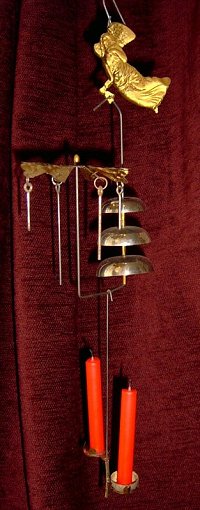
Nos.
2-3: “Engel-Geläut” Christmas tree ornament
Although the boxes bear no maker’s
mark, these chimes are also almost certainly by the firm of Gebrüder
Rauh. Meant to hang in the boughs of a Christmas tree, they
incorporate many of the same design features found in the full-size
Engel-Geläute, including the hand-shaped candle holders, distinctive
angels, and a similar — but even more elaborate — counter-balanced
mechanism of candle, impeller, and chime. Model no. 2, the 1-bell chime (first
two photos below), was powered by a single candle, and came three
to a box; no. 3, the 3-bell version (left, and third photo below), which
ran on two candles, was sold singly.
Below is a detail from the 1906
"Stern von Bethlehem” tree-topper ad illustrated above, describing
these two Engel-Geläute, and giving prices.
 |
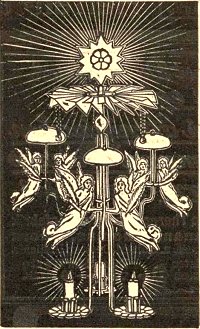
Engels "Christbaumgeläute 'Engelfreud'" (Christmas Tree Chimes
'Angel-Joy') (28.5 x 16 cm.)
Engels "Christbaumgeläute" (Christmas Tree Chimes)
(28.5 x 16 cm.)
Keydel “Angel Chimes” (28.5 x 16 cm.)
Keydel “Electric Angel Chime” (28.5 x 16 cm.)
Another attractive and very
successful competitor to the Stock line of chimes was the Christbaumgeläute model series
first manufactured by the
appropriately-named Friedrich Wilhelm Engels of Solingen. Again, the
earliest advertisement seen for this chime (right) dates to about
1906, suggesting that the design was developed to compete with the
Stock Engelgeläute. If the claim of 500,000 sold can be believed,
this was one of the more popular German candle chimes on the market.
Manufactured from ca. 1906 through the late 1920s in both Germany
and the US, it was certainly one of the longest-lived. The basic
design consists of three interlocking supports, each carrying a
candle holder, a chime, and a pair of stamped angel figures. The
impeller, topped with a star, is mounted on a central spike. The
angel figures on this chime are attractively and delicately modeled
in low relief, and the bells have a particularly sweet tone. the
earliest advertisement seen for this chime (right) dates to about
1906, suggesting that the design was developed to compete with the
Stock Engelgeläute. If the claim of 500,000 sold can be believed,
this was one of the more popular German candle chimes on the market.
Manufactured from ca. 1906 through the late 1920s in both Germany
and the US, it was certainly one of the longest-lived. The basic
design consists of three interlocking supports, each carrying a
candle holder, a chime, and a pair of stamped angel figures. The
impeller, topped with a star, is mounted on a central spike. The
angel figures on this chime are attractively and delicately modeled
in low relief, and the bells have a particularly sweet tone.
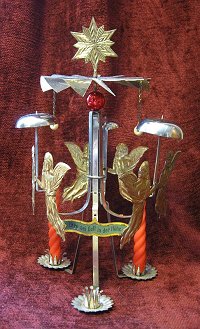
Engels "Christbaumgeläute 'Engelfreud'"
This
"Angel-Joy" model appears to be the more expensive (Mark 1.50)
version alluded to in the Engels ad illustrated above. In addition to the basic
features described above this example has angel figures in gold
instead of the usual silver, a glass bead detail on the central
spike, and a little detachable banner reading "Ehre sei Gott in der Höhe" (Glory to God in the Highest),
a design element very likely "borrowed" from the Rauh “Engel-Geläute Stern von Bethlehem.” All
early versions of this chime came disassembled and folded in a small
plain box; this example was found in an unusually complete state,
including its original instruction leaflet.
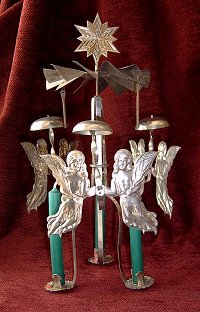
Engels "Christbaumgeläute"
This
less-elaborate example of the Engels "Christbaumgeläute" represents
perhaps the earliest German candle chime imported to America.
According to the instruction leaflet it was distributed for Engels
in the United States by Joseph P. Steiner of Milwaukee,
WI. (Milwaukee had large population of recent German immigrants at
this period.) It differs from the 'Engelfreud' model in that the
angels are silver, not gold; and neither "Glasperle" nor banner is
included. Like the version illustrated above, this model came disassembled and
folded in a small plain box. Note the picture of the chime used as a tree topper,
reproduced below from the original instruction/advertising leaflet.
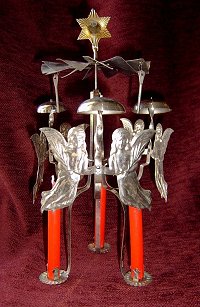
Keydel “Angel Chimes”
By the mid-to-late 1920s the
Keydel Company of Detroit, MI had taken over the U.S. distribution
of this chime, and perhaps the manufacture as well. As marketed by
Keydel, the candle chime had a smaller, six pointed gilt star, and came
almost fully assembled in a larger box decorated with lithographic
images and text (below, right). The box says ‘patents applied for,’ but no American
patent for this candle chime has yet come to light. In 1927 the
candle chime appeared in Sears, Roebuck catalogues for the princely
sum of 79 cents.

Keydel/Propp “Electric Angel Chime”
In 1923 Keydel patented an electrically-powered angel chime
(original patent drawing at far left, below),
which was eventually produced and marketed at about the same time as the candle chime.
The electric motor, which rotated the strike mechanism and lit up a
C6 bulb topper, was powered by a cord tipped with a plug designed to
screw into an empty socket of a C6 Christmas light string. The motor
of the original Keydel model was a bit small for the job, and later
models (marketed by the Propp company) had larger coils. In 1926 the
Keydel "Electric Angel Chime" was advertised in magazines like
Popular Mechanics for $1.50 (right), and in 1927 it appeared in the
Sears, Roebuck catalogue for $1.39, paired with its
candle-powered cousin at $.79. was powered by a cord tipped with a plug designed to
screw into an empty socket of a C6 Christmas light string. The motor
of the original Keydel model was a bit small for the job, and later
models (marketed by the Propp company) had larger coils. In 1926 the
Keydel "Electric Angel Chime" was advertised in magazines like
Popular Mechanics for $1.50 (right), and in 1927 it appeared in the
Sears, Roebuck catalogue for $1.39, paired with its
candle-powered cousin at $.79.
The Engels/Keydel/Propp
line of angel chimes was manufactured for
nearly thirty years (a long life-span for a product of this kind),
and by the time Keydel began marketing the chime in the U.S. the
molded figures had lost much of their fine detail — collectors will
prefer the earlier German-made versions whenever possible.
|
For More Pictures and Information,
Visit:
____________________________
Introduction & History
____________________________
Gallery Page One
Adrian & Stock and the Origins of
the "Angel Chime"
____________________________
Gallery Page
Two
Other Pre-WWII Chimes
____________________________
Gallery Page
Three
"Swedish Pattern" and
Other Post-WWII Angel
Chimes
____________________________
|
Please note: the chimes
illustrated on this site are from the
author's personal
collection, and they are not for sale. For those wanting to
buy
particular chimes illustrated here, eBay is the best source. The
author welcomes comments, additions and corrections, particularly
information on manufacturers and variant models, as well
as advertisements and entries
in contemporary catalogs.
Eric Holzenberg
boreas58@verizon.net
|
|
